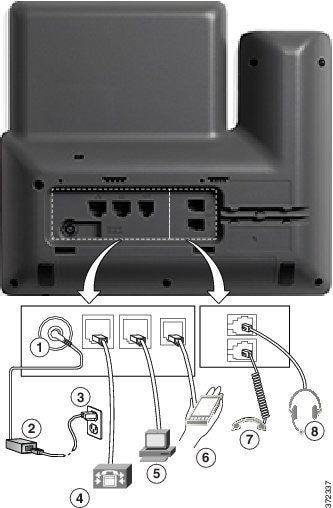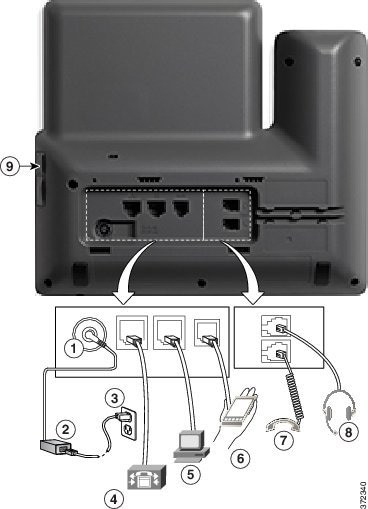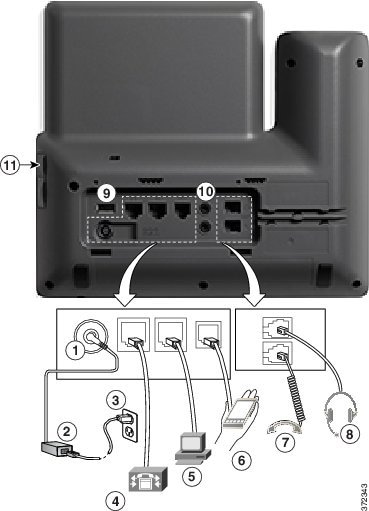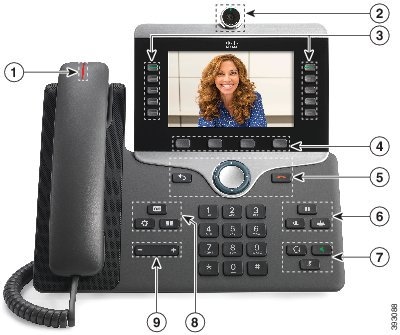The Cisco IP Phones 8811, 8841, 8845, 8851, 8861, and 8865 provide voice communication over an Internet Protocol (IP) network.
The Cisco IP Phone functions much like a digital business phone, allowing you to place and receive phone calls and to access
features such as mute, hold, transfer, speed dial, call forward, and more. In addition, because the phone connects to your
data network, it offers enhanced IP telephony features, including access to network information and services, and customizable
features and services.
The Cisco IP Phone 8811 has a grayscale LCD screen.
The Cisco IP Phones 8841, 8845, 8851, 8861, and 8865 has a 24-bit color LCD screen.
The Cisco IP Phones have the following features:
-
Programmable feature buttons that support up to 10 lines or that can be programmed for other features
-
Gigabit ethernet connectivity
-
Bluetooth support for wireless headsets (Cisco IP Phone 8845, 8851, 8861 and 8865)
-
Support for an external microphone and speakers (Cisco IP Phone 8861 only)
-
Network connectivity by Wi-Fi (Cisco IP Phone 8861 and 8865)
-
USB ports:
-
Support for up to 3 key expansion modules:
A Cisco IP Phone, like other network devices, must be configured and managed. These phones encode and decode the following
codes:
- G.711 a-law
- G.711 mu-law
- G.722
- G.722.2/AMR-WB
- G.729a/G.729ab
- iLBC
- OPUS
- iSAC
Cisco IP Phones provide traditional telephony functionality, such as call forward, transfer, redial, speed dial, conference
and voicemail system access. Cisco IP Phones also provide a variety of other features.
As with other network devices, you must configure Cisco IP Phones to prepare them to access Third-Party Call Control system and the rest of the IP network. By using DHCP, you have fewer settings to configure on a phone. If your network requires
it, however, you can manually configure information such as: IP address, netmask, gateway and primary/secondary DNS servers.
Cisco IP Phones can interact with other services and devices on your IP network to provide enhanced functionality. For example,
you can integrate Third-Party Call Control system with the corporate Lightweight Directory Access Protocol 3 (LDAP3) standard directory to enable users to search for coworker
contact information directly from their IP phones.
To function in the IP telephony network, the Cisco IP Phone must connect to a network device, such as a Cisco Catalyst switch.
You must also register the Cisco IP Phone with a Third-Party Call Control system before sending and receiving calls.
Finally, because the Cisco IP Phone is a network device, you can obtain detailed status information from it directly. This
information can assist you with troubleshooting any problems users might encounter when using their IP phones. You can also
obtain statistics about a current call or firmware versions on the phone.

Caution |
Using a cell, mobile, or GSM phone, or two-way radio in close proximity to a Cisco IP Phone might cause interference. For
more information, see the manufacturer’s documentation of the interfering device.
|






 Feedback
Feedback